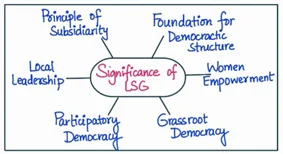Answer:
| Approach:
Introduction:
- Begin by highlighting the shift in focus for local institutions in India from ‘Functions, Functionaries, and Funds’ to ‘Functionality’ and emphasize the importance of effective governance, service delivery, and responsiveness to local communities.
Body:
- Briefly mention the critical challenges faced by local institutions in terms of functionality.
Conclusion:
- Conclude, suggesting potential solutions or recommendations.
|
Introduction:
The evolution of local institutions in India has witnessed a significant transition from their formative phase, which was primarily focused on ‘Functions, Functionaries, and Funds,’ to the contemporary stage emphasizing ‘Functionality.’ This shift underscores the importance of effective and efficient governance, service delivery, and responsiveness to the needs of local communities.

Body:
However, in recent times, these institutions have faced numerous challenges that hinder their ability to achieve the desired functionality. Some of these challenges are as follows:
- Lack of Capacity and Skills: This is due to inadequate training and orientation of functionaries, limited access to technical expertise, and a lack of motivation among personnel.
- Inadequate Financial Resources: This is often a result of poor revenue generation, inefficient tax collection, and inadequate fiscal devolution from higher levels of government.
- Political Interference: Local institutions often face undue political interference from higher levels of government, which can undermine their autonomy and decision-making authority.
- Corruption and Lack of Transparency: Corruption and lack of transparency, not only leads to inefficient resource allocation but also erodes the trust of citizens in these institutions.
- Ineffective Citizen Participation: Despite the existence of participatory mechanisms like Gram Sabhas and Ward Committees, citizen participation often remains superficial, and decisions are taken without genuine involvement of the community.
- Social Exclusion: Marginalized communities, such as women, Scheduled Castes, Scheduled Tribes, and other vulnerable groups, are often underrepresented in local institutions, which exacerbates existing inequalities and limits the effectiveness of these institutions in addressing the needs of these communities.
- Fragmented Governance: The multiplicity of local institutions, such as Gram Panchayats, Urban Local Bodies, and various line departments, often leads to fragmented governance and a lack of coordination among them. This results in overlapping functions, duplication of efforts, and inefficiencies in service delivery.
- Poor Monitoring and Accountability: The weak monitoring and accountability mechanisms at the local level make it difficult to assess the performance of local institutions and ensure that they are effectively addressing the needs of their constituents.
Conclusion:
To overcome these challenges and enhance the functionality of local institutions, concerted efforts must be made to strengthen their capacity, improve financial resources, promote transparency and accountability, foster meaningful citizen participation, and ensure greater inclusiveness in decision-making processes.
